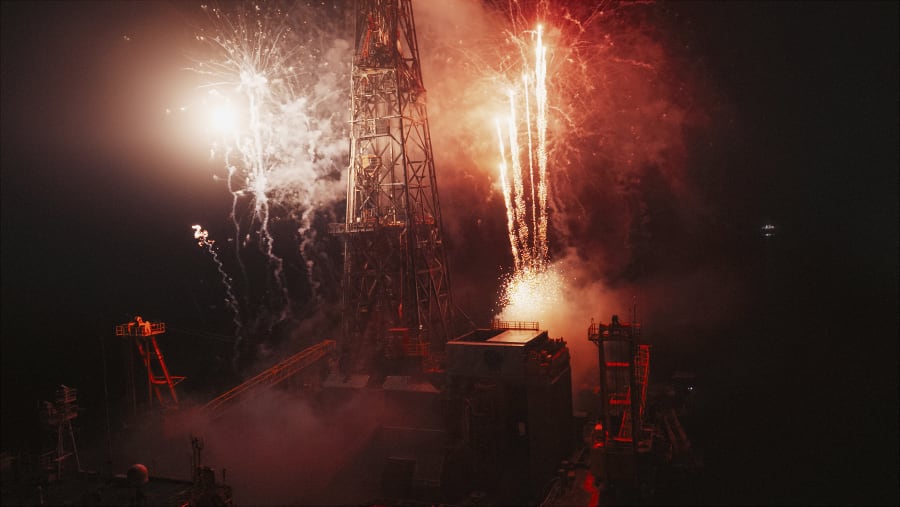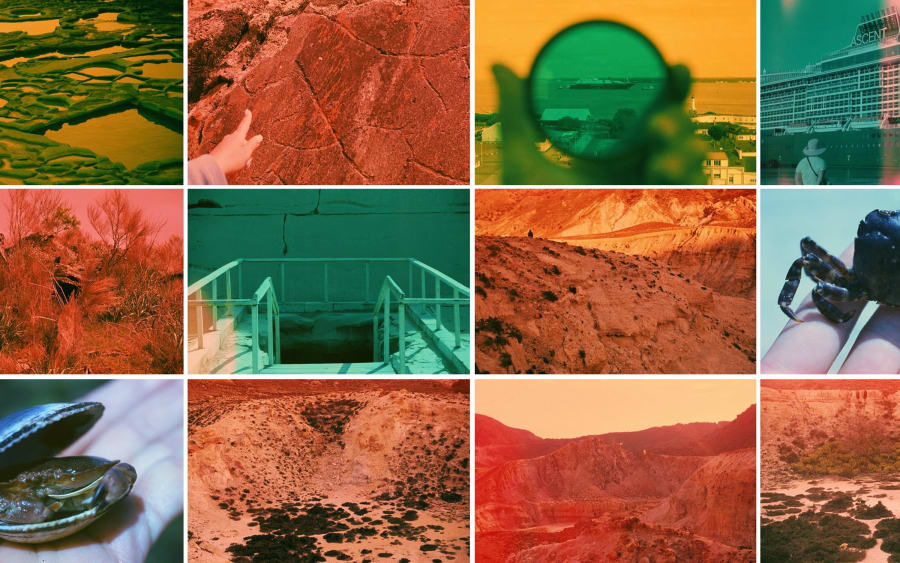The work: Carrie Mae Weems, Painting the Town #17, 2021
The presenting gallery: Fraenkel Gallery, booth A13
Why it matters: Appearing almost as abstract paintings, this photograph of boarded-up windows following the 2020 Black Lives Matter protests in Portland, Oregon conceals layers of censored slogans beneath, documenting themes of racial justice and the erasure that followed civil unrest.
The work: Marcel Duchamp, L.H.O.O.Q. Rasée, 1965
The presenting gallery: Galerie 1900-2000, booth G6
Why it matters: In this late iteration of Duchamp's scandalous 1919 Dadaist masterwork – originally a mustachioed Mona Lisa whose title phonetically spelled out a ribald French pun – the moustache is whimsically removed, perpetuating Duchamp's subversion of artistic sanctity and cultural reverence.
The work: László Moholy-Nagy, CH Space 6, 1941
The presenting gallery: Galerie Le Minotaure, booth F17
Why it matters: This ensemble of seven works reflects Moholy-Nagy’s pioneering approach to abstraction in the industrial age, using modern materials and techniques to explore light, motion, and perception – principles that fundamentally shaped Bauhaus pedagogy and modern design thinking.
The work: Martin Kippenberger, Modell Interconti, 1987, table with Gerhard Richter painting, 1973
The presenting gallery: Layr, booth L16
Why it matters: Kippenberger's deliberate purchase and transformation of monochrome grey Richter painting into a coffee table irreverently challenges the elder artist's authority, boldly marking a generational shift in post-war German art.
The work: Kara Walker, The Gates of Hello!, 2024
The presenting gallery: Sikkema Malloy Jenkins, booth R16
Why it matters: Kara Walker’s collage Infinitude (2024) is as exquisite as it is harrowing. Beautifully painted cut-out silhouettes are falling as if thrown overboard during the Middle Passage or dumped in a mass grave. This piece captures some of the foundational themes of Walker’s practice with a starkly efficient economy of means.
The work: Paul Thek, Sicily, 1962-63
The presenting gallery: Pace Gallery, booth A7
Why it matters: This semi-abstract piece is informed by Thek's first journey to Europe. The deep reds and browns of the land it depicts appear to announce the ‘Technological Reliquaries’ for which the artist is best-known, which were, in part, inspired by Palermo’s famous Capuchin Catacombs.
The work: Niki de Saint Phalle, I woke up last night, 1994
The presenting gallery: Galerie Georges-Philippe & Nathalie Vallois, booth E10
Why it matters: Best known for her monumental female ‘Nana’ sculptures, Niki de Saint Phalle pays homage here to her late husband Jean Tinguely. Bursting with vivid colours, I Woke Up Last Night is equipped with a photo-sensor which detects viewers’ presence and triggers Tinguely-esque motion. A beautiful ode to artistic kinship.
The work: Helen Frankenthaler, Swan Lake 1, 1961
The presenting gallery: Yares Art, booth E14
Why it matters: This is a classic Frankenthaler – with a twist. Characterized by its vibrant lake-like blue and beach-like yellow, this piece by one of the leading proponents of the Color Field painting movement holds a surprise. In the voids left out by the blue, bird shapes emerge, testing the porous boundary between abstraction and figuration.
The work: Maria Lassnig, Blauer Weicher, 1998
The presenting gallery: Petzel, booth A3
Why it matters: An introspective, uncharacteristically abstract self-portrait from 1998, the work has never been exhibited publicly.
The work: Philip Guston, Migration, 1978
The presenting gallery: Hauser & Wirth, booth C10
Why it matters: A museum quality, large scale work: Migration’s subject is forced migration driven by war, a highly topical subject. It is accompanied by two other rare Gustons.
The work: Jean Tinguely, Baluba II, 1961
The presenting gallery: Hauser & Wirth, booth E16
Why it matters: Tinguely revolutionized sculpture by introducing kinetic motion, transforming static art into dynamic experience. Baluba II is a prime example of the practice.
The work: Pierre Soulages, Peinture 130 x 88,5 cm, 1955
The presenting gallery: Applicat-Prazan, booth E16
Why it matters: Paired with another rare work from the same period, this extraordinary canvas by the French master was created during a time of intense experimentation – magnificently echoing the artist's interest in gesture, calligraphy, and, of course, the color black.
The work: Wade Guyton, Untitled, 2024
The presenting gallery: Galerie Gisela Capitain, booth R8
Why it matters: Known primarily for his abstracted paintings made with a massive printer, Wade Guyton has also explored sculpture – a medium he approaches with the same seductive taste for ambiguity and radicality that runs through his canvases, as exemplified by this 2024 work.
The work: Carmen Herrera, Untitled, 1948
The presenting gallery: Lisson Gallery, booth U17
Why it matters: Early works by Herrera – the late and great grande dame of geometric abstraction – are rarely seen at art fairs. In this small yet mighty canvas from 1948, the Cuban-American painter’s precision and ability to build tension shine brightly.
The work: Julius von Bismarck, Over the Ocean the Other Sun is Burning, 2025
The presenting gallery: Esther Schipper, booth S1
Why it matters: Made with a hair-raising list of materials – including plants, a taxidermized octopus, and sponges – this triptych was created using an innovative pressing technique and can be folded or opened up, like an altar to the limitless possibilities of the natural world.
Art Basel in Basel takes place from June 19 to 22, 2025. Get your tickets here.
These Editors’ Picks were written by members of Art Basel’s Editorial team:
Alicia Reuter, Patrick Steffen, Karim Crippa: Senior Editors
Juliette Amoros: Associate Editor
Kimberly Bradley: Commissioning Editor
Coline Milliard: Executive Editor
Anna Sze: Chinese Assistant Digital Editor
Jeni Fulton: Head of Editorial
Suzanne Lai: Marketing Content Manager Asia
Patricia Li: Regional Head of Marketing & Communications Asia
Caption for header image: Katherine Bernhardt, Enoki, 2025. Courtesy of the artist and David Zwirner.
Published on June 11, 2025.


